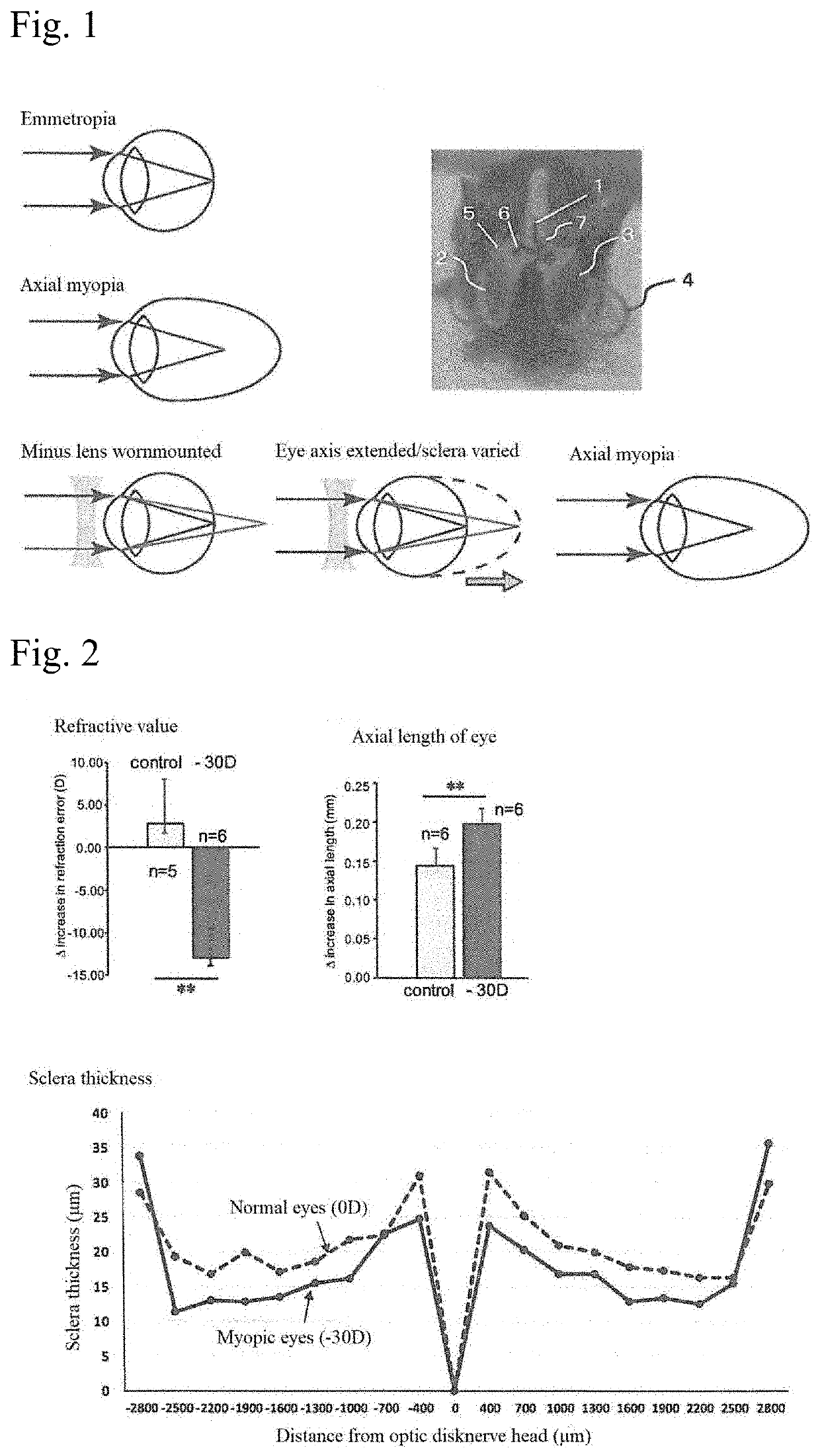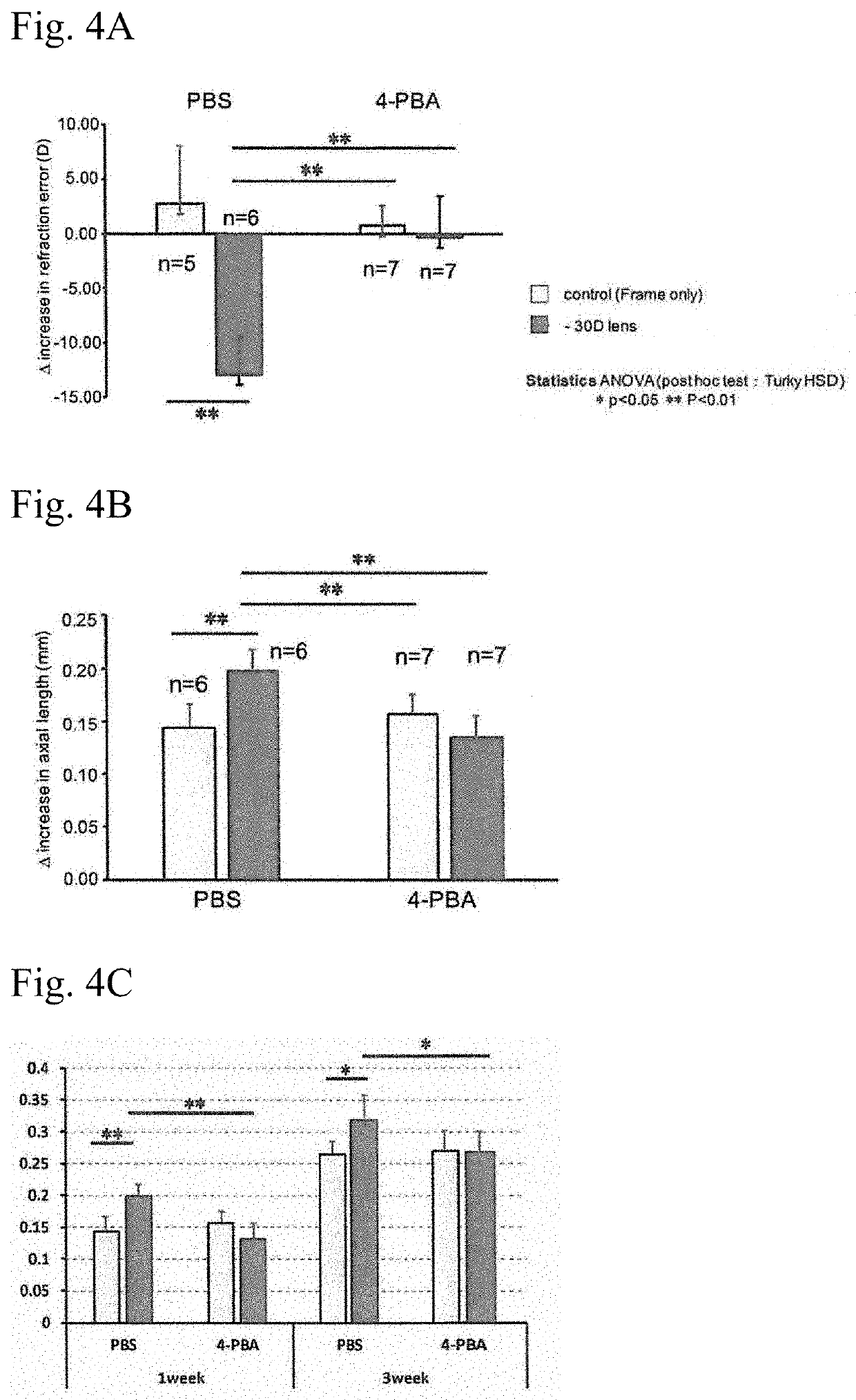Mouse myopia-induced model and endoplasmic reticulum stress suppressant for preventing and suppressing myopia
a technology of endoplasmic reticulum and model, which is applied in the field of mouse myopia-induced model and endoplasmic reticulum stress suppressant for preventing and suppressing myopia, can solve the problems of inability to effectively treat myopia, the molecular mechanism of occurrence and progression of myopia has not been clarified at all, and various abnormalities in the fundus
- Summary
- Abstract
- Description
- Claims
- Application Information
AI Technical Summary
Benefits of technology
Problems solved by technology
Method used
Image
Examples
example 1
[Example 1] Preparing of Mouse Myopia-Induced Model
[0050]First, a description will be given below with respect to a method for preparing a mouse model of the present invention. FIG. 1 schematically shows a mechanism in which a minus lens is worn to induce the axial myopia. The emmetropia refers to a condition in which parallel rays entering the eyes focus into an image on the retina and thus one can see images clearly. On the other hand, the axial myopia refers to a condition in which parallel rays entering the eyes focus into an image in front of the retina because of long axial length of the eye, and thus one cannot see clearly. The eyes of animals, including a human, enlarge as they grow. If a juvenile mouse is worn with a minus lens, the eye axis will extend to the position at which an image is focused when the minus lens is worn, i.e., the condition in which one can see clearly with the minus lens worn. As a result, the eye axis extends, resulting in an eye condition similar to...
example 2
[Example 2] Screening of the Therapeutic Agent Using the Mouse Myopia-Induced Model
[0058]To investigate the pathological condition of the myopia-induced model in more detail, a transmission electron microscope (TEM) was used for analysis. An eyeball that was worn with a minus lens for three weeks and had axial myopia induced thereto and an eyeball that was worn with only a frame as a control were removed from a mouse and then fixed in 2.5% glutaraldehyde / physiological saline for one hour at 4° C. The cornea was removed and post-fixed in 2.5% glutaraldehyde / physiological saline overnight. It was then embedded in Epok 812 (Okenshoji Co., Ltd.) and thinly sectioned for observation under TEM (JEM-1400 plus, JEOL Ltd.). In FIG. 3, the upper shows the control and the lower shows the sclera of the sample from the mouse that was worn with the −30D lens and had myopia induced thereto. The scale is 1.0 pin, 500 nm, and 500 nm from left to right.
[0059]The upper image of the control shows that ...
example 3
[Example 3] Effects of Endoplasmic Reticulum Stress Induction on Myopia
[0073]Because the endoplasmic reticulum stress suppressant has a suppression effect on myopia induction as describe above, it is considered that the endoplasmic reticulum stress directly participates in myopia induction. Then, an analysis was conducted to check for induction of myopia by administration of an agent for inducing endoplasmic reticulum stress. The subject was a 3-week-old male C57BL6J mouse (n=12). The right eye of the mouse was administered once by eye drop with 50 μg / ml of tunicamycin (Tm) (Sigma-Aldrich Co. LLC) or 10 μM of thapsigargin (TG) (Wako Pure Chemical Industries, Ltd.), and the left eye was administered once by eye drop with PBS (Veh). Before and at one week after administration of tunicamycin and thapsigargin, the refractive value and the axial length of the eye were measured to calculate the variation (FIG. 7).
[0074]By administration of either agent of tunicamycin and thapsigargin, whi...
PUM
| Property | Measurement | Unit |
|---|---|---|
| OD | aaaaa | aaaaa |
| endoplasmic reticulum stress | aaaaa | aaaaa |
| angle | aaaaa | aaaaa |
Abstract
Description
Claims
Application Information
 Login to View More
Login to View More - R&D
- Intellectual Property
- Life Sciences
- Materials
- Tech Scout
- Unparalleled Data Quality
- Higher Quality Content
- 60% Fewer Hallucinations
Browse by: Latest US Patents, China's latest patents, Technical Efficacy Thesaurus, Application Domain, Technology Topic, Popular Technical Reports.
© 2025 PatSnap. All rights reserved.Legal|Privacy policy|Modern Slavery Act Transparency Statement|Sitemap|About US| Contact US: help@patsnap.com



